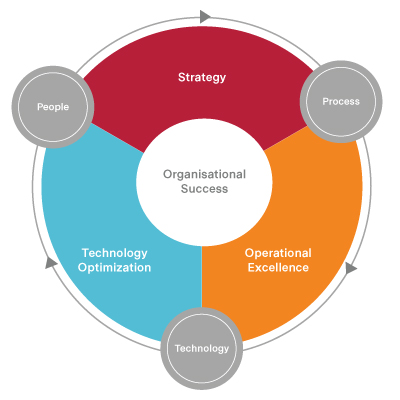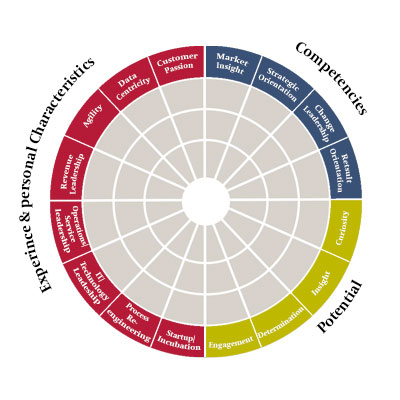The telecom industry in India has witnessed exponential growth over the past decade. Changes have stemmed from both technological innovation and government regulations. The roll out of advanced technologies (3G and 4G), affordable tariff plans, evolving consumption trends, and a friendly regulatory regime have created a favourable environment for operators. However, this advantageous environment has also created intense market competition and tariff wars, leading to a new challenge: How do companies transform into a hybrid of telecom operator and technology player? This type of large-scale transformation requires leaders who understand technology with a proven ability to transform organizations – a rare find.
An Environment Suited for Change
Many players, after a series of churns, have now reached a phase of consolidation, blurring the lines between telecom operators and technology players. Some examples include:
New Avenues for growth: Today, most progressive telecom operators are leveraging a connected world and advanced technologies, such as IoT, Analytics, and AI/ML, to become smart about day-to-day operations. They are moving beyond their core businesses to offer ancillary products and services, enabled by cloud/Saas/Paas, thus harmonizing unit economics. For example, several of them are charting out cloud strategies, transforming themselves into integrated ICT providers. They are offering cloud, security, and workplace solutions either on their own (JioCloud) or through partnerships (Vodafone with Google Cloud, Airtel with Microsoft and AWS); and by bundling or unbundling the services (Airtel, Hike). Some telecom companies are venturing into Digital Payments, where telecom operators have the potential to play a larger role in the digital ecosystem. Others, in an attempt to grow the revenues through Enterprise users, are catering to evolving needs with a range of workplace solutions. This is further bridging the gap between Enterprise IT and telecom.
Content as the strategic lever: The reduction in data tariffs and affordable smartphones has resulted in exponential growth in data consumption, rendering smartphones the preferred screen for entertainment. This has set the scene for content to become the differentiator for customer acquisition and retention. Telecom operators are investing in high-quality broadcasting content. A few are creating their own content platform to monetise and deliver digital content; while others are entering into partnerships with content providers, such as Amazon, Netflix, Hotstar, Zee Entertainment, Viu, and Spuul, to provide the best options to subscribers while keeping the cost of content ownership low.
Asset Sharing: The operator’s ability to sustain minimum infrastructure and resources to enable a seamless experience across multiple platforms over fast and reliable technologies (such as 5G) is paramount. Operators are thus engaging in active resource sharing models for scale and sustained operations.
Given this rapidly changing environment, the organization’s ability to succeed in this new era will depend on how well they are able to transform and reinvent themselves. The three most significant factors that will drive and guide this change agenda are people, process, and technology.

Figure 1: People, Process and Technology
For instance, if a telecom operator wants to deliver digital content, they would need to have the platform/solution in place to broadcast the content (Technology), decide whether to pursue organic or inorganic means to develop and deliver content (Strategy/Process) and lastly, hire talent with a strong understanding of consumer media to execute the plan (People).
The Change Agent
Focusing on the People part of the solution, what type of talent do organizations need to evolve? It is our belief, gathered through our leadership advisory work with several of our clients that change agents will play a critical role in how organizations reinvent themselves. The change agent will need to be someone who brings the skill and potential to stimulate the change effort. The DNA of the change agent would include the ability to handle ambiguity, analyze and glean insights from data, “connect the dots” on seemingly unrelated trends, make quick decisions, learn from mistakes, build on success, be comfortable in dealing with and driving change through influence and collaboration.
Betting on Potential
As constant change becomes a norm in the telecom industry, assessing candidates on past performance and existing competencies is simply not a strong enough indicator of future success. We need to look beyond empirical evidence and bet on an executive’s potential to grow, both professionally and personally. Potential, as defined by Egon Zehnder, helps organizations understand how far their talent can develop and whether an individual’s ability to adapt and grow aligns with the company’s transformation objectives. Past performance and competencies are then helpful barometers to determine how much of his/her potential has been unlocked.

Figure 2: The Framework for Identifying the Change Agents
Through research and the observation of thousands of senior executives around the world over the past decade, we have identified several factors that help identify an individual’s potential, and help determine an individual’s ability to grow into the type of leader needed to drive the change required:
-
Curiosity: Is driven to proactively seek understanding and new learning throughgaining fresh ideas, varied experiences and the latest information. This curiosityalso means that he/she actively works on personal development.
-
Insight: Processes a vast range and amount of information from many kinds ofsources and uses this information to shape insights that make sense of ambiguity,simplify complexity and break the status quo.
-
Engagement: Connects with people because he/she empathises with theirmotivations, priorities and logic. His/Her enthusiasm, energy and sense ofpurpose are infectious; he/she engages the hearts and minds of others to delivershared objectives and mutual benefits.
-
Determination: Enjoys a challenge, overcomes obstacles and willingly takes onhigher risk opportunities with ingenuity and tenacity.
Additionally, organizations should also consider expanding the scope of vision and assessing candidates from other industries, even completely unrelated domains. In essence, hiring these leaders can foster new learnings, encourage cross-pollination of ideas, and help adapt to complex challenges that are still unknown. Essentially, hire for the future while ensuring business as usual for the present. Given this context, favourable traits to look for would be:
-
Customer centricity
-
Digital-first or digital natives
-
Agility
-
Adaptability
Customer-centricity requires being close to the customers and understanding their pulse. For instance, Telecom operators should look at sectors known for their customer-centric attitude, such as fast moving consumer goods and retail banking. Having said that, they should not shy away from completely unrelated sectors if they see future potential. Similarly, for digital-first, e-commerce firms, management consulting firms, digital advertising and media are the obvious choices. For example, Airtel hired a former Facebook and NASA executive to bring data science and deep analytics capabilities to both understand customer needs and develop innovative products and services.
Case Study: A Telecom Operator in Asia
We have seen success in applying the potential model, both internally and externally, for one of our clients in Asia. Our client is one of the leading telecommunications groups in Asia with controlling interests in multiple mobile operators. The company provides mobile communications, interactive services, and multimedia solutions. In 2016, the parent group faced a challenging financial year and dealt with unprecedented economic headwinds. As our client was the largest operating company within the Group, refreshing the management team would impact the entire organization. The Group aimed to revitalize growth and was willing to invest in revamping its culture by hiring high-calibre change agents that are able to embed new and better ways of working to help accelerate the new business transformation as well as create a performance culture within the operating company. These individuals not only needed to have the necessary functional experience and qualifications, but also the experience of having driven change in very difficult circumstances. Typically, state-owned companies have preferred to hire multinational talent. This talent pool is seen as highly professional, performance-driven and experienced, and exposed to best practices and good standards. However, making the switch from a multinational environment to a more local one is not easy, and most struggle with the ambiguity, politics, lack of structure and a culture that is less performance-focused. Over time, they are seen as “not performing” and will most likely leave. The Group wanted to find candidates with multinational company experience but with a maverick DNA and place them across all levels of the organization. Beyond their technical and functional skills, qualified candidates who were identified as change agents -- through Egon Zehnder’s proprietary assessment framework -- needed to demonstrate critical competencies, including their inherent potential to grow as leaders.
To date, 65 change agents (~35 internal, 30 external) have been identified and placed across the organization. They not only lead within their functional roles, but also work with cross-functional teams to drive collaboration and engagement across the organization.Because telecom operators are competing with other technology, media and consumer players for their future talent pool, attracting and retaining the needed talent must be a top priority. As they drive and navigate through changing times, leaders with strong program management capabilities, or a background in IT / technology, sales & marketing, digital and analytics to help the operator on its transformation journey will be a differentiator.





